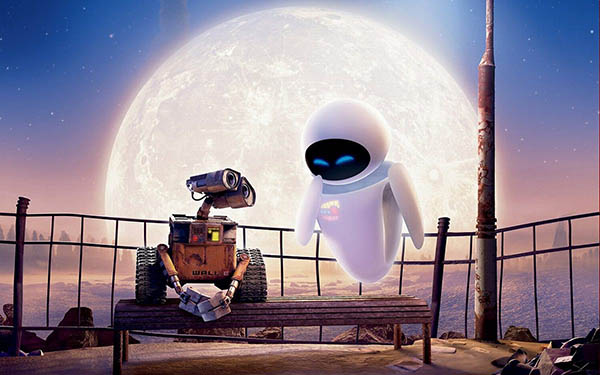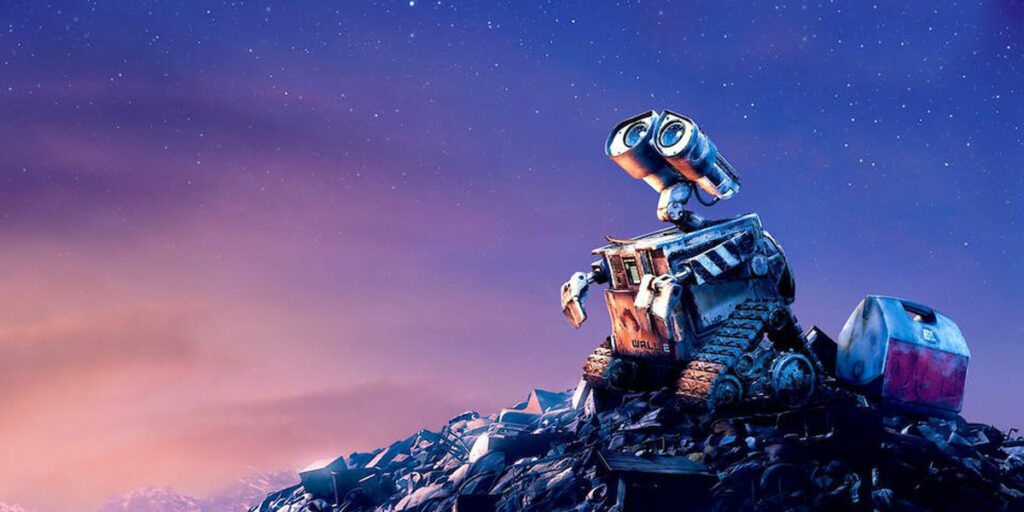WALL-E is a celebration of culture, a warning against consumerism, and a family-friendly sci-fi adventure, making it one of Pixar’s defining achievements.
The best Pixar movies blend original ideas and stellar animation with narrative structures that are steeped in tradition. WALL-E (2008) checks this box and many others, making it one of the most personal, beautiful, and surprisingly biblical films in all of Pixar’s catalogue. It combines genres and long-established story arcs to discuss themes like consumerism, environmentalism, the importance of physical connection, and more, all under the guise of an entertaining children’s film.
WALL-E is first, and perhaps foremost, a science fiction adventure. The premise involves a dystopian world where Earth has been all but destroyed by a disastrous neglect of caring for the environment. One robot, WALL-E (Waste Allocation Load Lifter: Earth Class) remains operational, desperately trying to clean up a world that is seemingly far beyond saving. The story features robots, giant space stations, AI that wants to take over everything, and other elements that are typical of the science fiction genre.
Savvy audiences are sure to pick up on references to 2001: A Space Odyssey and other classic sci-fi films, as well. This science-fiction backdrop allows WALL-E to efficiently explore themes that are common to the genre. The dystopian setting is perfect to examine ideas relating to how human beings are capable of destroying ourselves and our planet and how technology and the corporate world has caused a disturbing level of complacency at the expense of real human connection. WALL-E tackles these complex subjects in ways that our fun and easily accessible.
The animated film also draws heavily from early classic Hollywood tradition. Two distinct features of WALL-E will remind audiences of the golden age of cinema. First, the movie explicitly weaves different show tunes and older films into the plot. WALL-E carries a cassette tape that constantly plays a song from the musical Hello, Dolly! (1964). He uses an old television set to watch films that further connect him to Earth’s former culture. These scenes can be viewed as a longing for “the good ol’ days,” a reminiscing of sorts.
In this future, all culture has been lost to technology. The second half of the film deals with the humans who have escaped earth and now dwell on the space station Axiom. These humans have no access to arts or culture, consuming only what the megacorporation Buy n Large (BnL) supplies for them. The captain of the ship is confused about how books work, even. The classic Hollywood references not only supply the viewers with some fun references, but they also serve as a warning to not let culture itself be lost in the age of technology.

The character of WALL-E himself also serves as a touching homage to Hollywood legends of the past. The movie’s opening act features little dialogue, as WALL-E and his female counterpart EVE (Extraterrestrial Vegetation Evaluator), as robots, have little communication capabilities. Director Andrew Stanton, instead of dialogue, relies on visual storytelling, and more specifically, visual humor. The way WALL-E interacts with his surroundings (the scene that immediately springs to mind is when he frantically things he squashed his cockroach friend, Hal, after rolling over him) harkens back to silent-film era comedy legends like Charlie Chaplin, Harold Lloyd, and Buster Keaton. This visual storytelling works not only for the film’s humorous moments, but its emotional ones as well. Shots of WALL-E and EVE holding hands or dancing in space around the Axiom are both stunning and emotionally satisfying.
This relationship between WALL-E and EVE is a crucial component of the film’s plot, and one that draws on another specific narrative tradition. The most interesting allusions WALL-E makes are the references to the Biblical stories, especially the book of Genesis. WALL-E, the only sentient figure on Earth (aside from Hal), is charged with taking care of the planet (a reference to the Creation Mandate in Genesis 1:28, where God instructs humans to care for, replenish and subdue the earth). He is lonely until EVE (her name is not a mistake) descends from the heavens to Earth, where WALL-E is taken by her beauty.
While the setup almost perfectly mirrors the story of the biblical Adam and Eve, WALL-E subverts the archetype by making Earth a far cry from its original Edenic paradise. The film asserts that humans have not fulfilled their role in caring for the earth by drawing a distinct religious connection to its characters. In the film’s closing moments, the humans do finally return to earth, with their perspectives now changed thanks to the heroics of WALL-E and EVE. The finale can be seen as a return to the Promised Land. The plant that EVE first found on earth at the film’s beginning grows into a mighty tree, a symbol of hope that the planet, and humanity itself, can be restored.
This mish-mashing of styles, genres and narrative tradition is not to say the film is unoriginal or unimaginative. In fact, it is this blending of influences that makes the film unique and effective. Stanton collects data from a variety of sources, many of which audiences understand at a conceptual level, and provides a sense of comforting familiarity with his story. WALL-E works and stands the test of time because its story is one that can resonate with people on a variety of levels. There is something for everyone to enjoy, and something for everyone to learn. One may not need to know about Classic Hollywood, science fiction, or the Bible to appreciate WALL-E. The beauty of the film is that it can be enjoyed on a basic entertainment level for people of all ages, but there is also so much happening within the storytelling that reminds us how rich and beautiful our planet (and its cultures) can be.
WALL-E is now available to watch on digital and on demand.

